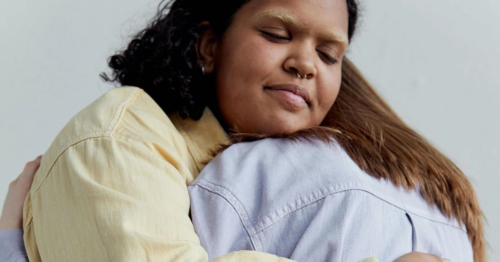
Table of Contents
Inviting In (Coming Out) 101

Written By: Alex Bachert, MPH
June 6, 2022
9 min.
“Coming out—or, as I and many others prefer to frame it, inviting in—is a deeply personal, powerful, and special act. It can also be pretty scary. We get that, and we’re here to help out.” Dr. Ley Cray, Charlie Health’s Director of LGBTQIA+ Programming
Learn more about our Clinical Review Process
Table of Contents
What does it mean to “invite in”?
Understanding and accepting who you are can be pivotal to a person’s sense of self, the decisions you make, and how you carry yourself through life. Each person is their own unique blend of things like race, ethnicity, and values; the special combination that makes you you. Some significant pieces of the puzzle that Charlie Health wants to focus on today are LGBTQIA+ identities, including sexual orientation and gender identity.
As described by the Trevor Project, sexual orientation has expanded to include different forms of attraction, behaviors, and identities. In today’s society (even in the year 2022), it’s often assumed that most teens are heterosexual, “meaning that they’re attracted to individuals of the so-called ‘opposite’ gender,” explains Dr. Ley David Elliette Cray, Director of LGBTQIA+ Programming at Charlie Health. “This phrasing, though, already makes some unfortunate assumptions, since in reality, sexual orientation and gender identity alike can be fluid and complex. This leads to a diversity that goes far beyond what some people initially recognize,” she said.
For those whose sexual orientation and gender identity do not fall in line with cisgender and heterosexuals norms, they’ll likely face the quandary of “coming out,” the process in which LGBTQIA+ individuals disclose their identity to others. The choice to “come out” is as unique to a person as their name or fingerprint, and it’s your prerogative to share the information with who you want, when you want, if you want.
Lately, though, the narrative has begun to shift away from “coming out” and toward the direction of “inviting in.”
Inviting in can be thought of as a more authentic way to empower LGBTQIA+ individuals to own their identity and share this deeply personal part of their lives with others. Instead of feeling pressure to share this special piece of you for someone else’s benefit, the concept recognizes that we’re all continuing to grow and evolve and that showing and acknowledging essential parts of ourselves can be an act of love and truth.
“The notion of ‘coming out’ originally traces back to LGBTQIA+ gatherings that might appear somewhat similar to debutante balls, typically held in coastal cities in the earlier parts of the 20th century,” explains Dr. Cray. “In time,” Cray continues, “the term sadly took on an association with closets and shame, in which coming out was something like a person taking a risk for the sake of acceptance and approval—and thereby putting most of the power in the hands of the person who could deny them what they were looking for. By reframing this act as one of inviting in, we cast away these connotations and keep the power in our own hands, offering knowledge of our authentic selves as a gift to those lucky enough to be brought into the loop.”
Coming out, inviting in: regardless of how you choose to look at it, sharing your identity with others can be an important step in prioritizing your mental and physical health. In the spirit of promoting self-love and self-care, Charlie Health has compiled a few tips to help LGBTQIA+ youth navigate the process of sharing their identity, as well as questions to help you understand when the time is right for you.
Join the Charlie Health Library
Get mental health updates, research, insights, and resources directly to your inbox.
You can unsubscribe anytime.
Four tips for coming out (aka inviting in)
1. Plan ahead
For the most part, major decisions require some serious contemplation and processing. For example, you probably wouldn't move to a different city or propose to your significant other without truly thinking through your choice. The same can be said for sharing an LGBTQIA+ identity with the world, or even just with friends and family.
Taking time for self reflection and planning allows you the opportunity to define yourself on your own terms, in your own way. Here are a few questions to consider when creating your plan for inviting others in.
- Who do I want to know?
- How do I want to inform them?
- Will I deliver the news in person, on the phone, or via social media?
- How much do I want to tell them?
- What if they don’t react how I expect them to?
As corny as it sounds, some people even find it useful to practice what they want to say in front of a mirror. Looking into your eyes and coming out to yourself—or inviting yourself in—can be extremely empowering as you prepare to invite other people into your world.
Just like with any major announcement, there’s bound to be a few follow-up questions, so it can be helpful to think about how you’d like to respond to those as well. Some examples include:
- How long have you known?
- What does this mean?
- How can I support you?
- Are there things I should and shouldn’t say to you?
- What are your pronouns?
- Can I set you up with someone?
And remember: it is absolutely okay to not know the answers to these questions. You do not owe anyone an explanation or justification of your identity in order to be valid.
2. Start small and be selective
Deciding to share your identity doesn’t mean that you need to shout it from the rooftops (although that’s more than ok too!). For many people, it’s easier to start with one or two people that they truly trust with this information. This might mean your best friend or sibling, or it could be someone less obvious like a classmate, teammate, teacher, counselor, doctor, spiritual leader, cousin, or neighbor.
As you read this, you might already have someone in mind that you feel comfortable sharing the news with first. If that’s true, stick with your gut and create a plan so that you feel confident and comfortable letting them into this part of your life. If you’re not convinced that you have the right person, consider the following questions to gauge what their potential reaction might be.
- How does this person react to LGBTQIA+ individuals or news?
- Have I ever trusted this person with personal information before?
- Will this person respect my privacy?
- Do I rely on this person for things like food and housing? What’s my plan if they respond negatively?
Do you need more support with
your mental health?
Charlie Health can help.
3. Be patient with yourself
As we mentioned earlier, inviting in is an ongoing process and the first step is acknowledging your own feelings. It’s an opportunity to be honest with yourself about a significant piece of the puzzle that makes you the person you are today. This self-acceptance also happens to be a really big deal and probably won’t happen overnight, so take your time processing the information.
Research shows that lesbian, gay, bisexual, and transgender youth are inviting in at an earlier age than previous generations, which often intersects with social and developmental periods of self-consciousness, conformity, and peer regulation. That means that there might be a lot on your plate all at once, which can feel overwhelming. Be patient with yourself and only tell others when you’re ready and feel confident and safe in doing so.
4. Be patient with others
Deciding to share your authentic self with another person can be an important step in that relationship. It means that you honor and accept yourself, and you trust and value the other person enough to want to share this important part of your identity with them. That person should be flattered!
In a perfect world, this person will respond with, “I love you, I see you, I thank you for telling me,” (or something along those lines). However, that’s not always the case. While you might have spent countless sleepless nights asking yourself the questions to get to this point, there’s a chance that your identity never crossed your friend or family member’s mind. In fact, they might not have ever been involved in a conversation like this before.
If you do receive an invalidating response, keep this in mind: you are absolutely, 100% valid. No one can succeed in invalidating you, no matter what they do or say, because you are the authority on your own identity. If someone isn’t ready to accept the gift that is your invitation, you can let them know that they can take some time to process and discuss when they are ready. And if they’re not willing to accept the gift, remember: you do not owe it to them.

Are you ready to come out?
Wanting to come out and being ready to come out are sometimes two very different things. So how do you know if the time is right? No one can answer that question other than you, but there are a few points to consider when deciding when to reveal your identity to others.
- You don’t want to hide an important part of who you are
- You want to connect with a large movement involving people with whom you share an identity
- You feel like you have a support system, or even just one ally, who you can trust
- You’re looking for a relationship that aligns with and affirms your identity
- You’re in a relationship and you’d like to introduce people to your partner
Depending on where you live and the people around you, safety might also be a factor in deciding if now is the right time to open up about your identity. Many youth find themselves asking if inviting people in will make their life more difficult—and, if so, what sort of difficulties will present themselves. These difficulties can be very real, and any nervousness that you might feel is understandable and valid.
One of the biggest risks that youth can face when coming out to parents or family members is being kicked out of their home. According to a study from Chapin Hall at the University of Chicago, LGBTQIA+ youth are 120 percent more likely to experience homelessness than non-LGBTQIA+ youth. That same report notes that while 7 percent of U.S. youth identify as LGBTQIA+, 40 percent of youth experiencing homelessness are LGBTQ. Research also shows that LGBTQIA+ youth who experience homelessness report more symptoms of mental health disorders and higher rates of suicidality.
Take care of yourself throughout the process
LGBTQIA+ youth may experience more body image issues, bullying, online harassment, and even physical threats of violence than their non-LGBTQIA+ peers, so it's important to remember to prioritize your mental and physical health.
Find a counselor or support group
Surround yourself with people who relate to or respect your identity. For example, LGBTQIA+ social media pages and news outlets can be instrumental in connecting you with a community that understands your experience.
Coming out, and even being out, can cause anxiety, depressive symptoms, and feelings of isolation. If you think you might benefit from mental health support, group sessions are a great way to create additional space to connect with peers and professionals about any challenges you’re struggling with. Often used in conjunction with one-on-one therapy, LGBTQIA+ support groups are a platform to share your feelings and to learn from others who can offer advice or support. Support groups might also help you feel less alone during a time that some people find to be extremely isolating.
Practice self care
Charlie Health has previously blogged about the importance of self-care, especially for LGBTQIA+ youth who are navigating the road of inviting in. Meditation, journaling, social media breaks, and spending time outdoors are all simple ways to show yourself compassion and respect.
Consult a helpline
For further support or in the event of an emergency, the following helplines are always available.
- The Trevor Project: 866-488-7386
- LGBT National Youth Talkline: 800-246-7743
- The Anti-Violence Project: 212-714-1141
- National Suicide Prevention Lifeline: Call 988 or text the Crisis Text Line: HOME to 741741
Inviting in with Charlie Health
Charlie Health is committed to serving LGBTQIA+ youth in a compassionate, accepting, and safe environment. Our virtual mental healthcare programs are designed to fit each client’s unique needs, plus help their families learn how to best support them as they navigate their journey toward healing and sustainable recovery from a wide variety of mental health struggles. Learn more about Charlie Health today.
References
https://www.thetrevorproject.org/wp-content/uploads/2019/10/Coming-Out-Handbook.pdf
https://www.fullerton.edu/lgbtq/_resources/pdfs/Coming%20Out%20vs.%20Inviting%20In%20Brochure.pdf
https://www.ncbi.nlm.nih.gov/pmc/articles/PMC4887282/
https://pubmed.ncbi.nlm.nih.gov/29322361/
https://lgbtqiahealtheducation.org/wp-content/uploads/2018/04/EatingDisordersBodyImageBrief.pdf
https://www.stopbullying.gov/bullying/lgbtq
https://publications.aap.org/aapnews/news/14054





